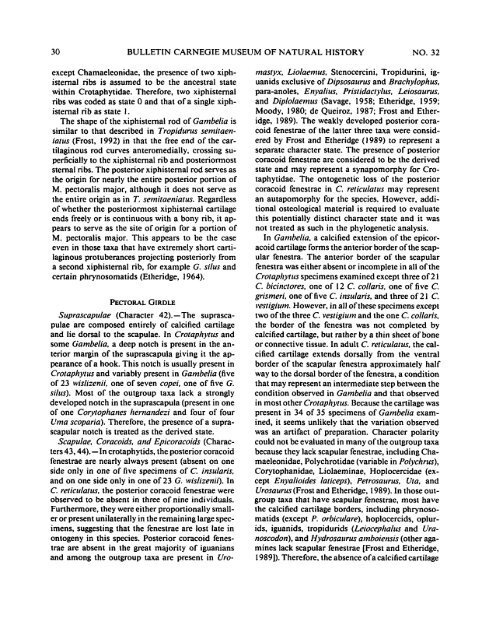Download Full Document - Mountain Boomer Music!
Download Full Document - Mountain Boomer Music!
Download Full Document - Mountain Boomer Music!
You also want an ePaper? Increase the reach of your titles
YUMPU automatically turns print PDFs into web optimized ePapers that Google loves.
BULLETIN CARNEGIE MUSEUM OF NATURAL HISTORY NO. 32<br />
except Chamaeleonidae, the presence of two xiph-<br />
isternal ribs is assumed to be the ancestral state<br />
within Crotaphytidae. Therefore, two xiphisternal<br />
ribs was coded as state 0 and that of a single xiph-<br />
isternal rib as state 1.<br />
The shape of the xiphisternal rod of Gambelia is<br />
similar to that described in Tropidunls semitaen-<br />
iarus (Frost, 1992) in that the free end of the car-<br />
tilaginous rod curves anteromedially, crossing su-<br />
perficially to the xiphisternal rib and posteriormost<br />
sternal ribs. The posterior xiphisternal rod serves as<br />
the origin for nearly the entire posterior portion of<br />
M. pectoralis major, although it does not serve as<br />
the entire origin as in T. semitaeniatus. Regardless<br />
of whether the posteriormost xiphisternal cartilage<br />
ends freely or is continuous with a bony rib, it ap-<br />
pears to serve as the site of origin for a portion of<br />
M. pectoralis major. This appears to be the case<br />
even in those taxa that have extremely short carti-<br />
laginous protuberances projecting posteriorly from<br />
a second xiphisternal rib, for example G. silus and<br />
certain phrynosomatids (Etheridge, 1964).<br />
Suprascapulae (Character 42).-The suprasca-<br />
pulae are composed entirely of calcified cartilage<br />
and lie dorsal to the scapulae. In Croraphytus and<br />
some Gambelia, a deep notch is present in the an-<br />
terior margin of the suprascapula giving it the ap-<br />
pearance of a hook. This notch is usually present in<br />
Croraphyrus and variably present in Gambelia (five<br />
of 23 wislizenii, one of seven copei, one of five G.<br />
silus). Most of the outgroup taxa lack a strongly<br />
developed notch in the suprascapula (present in one<br />
of one Corytophanes hernandezi and four of four<br />
Lrma scoparia). Therefore, the presence of a supra-<br />
scapular notch is treated as the derived state.<br />
Scapulae, Coracoids, and Epicoracoids (Charac-<br />
ters 43,44). -In crotaphytids, the posterior coracoid<br />
fenestrae are nearly always present (absent on one<br />
side only in one of five specimens of C. insularis,<br />
and on one side only in one of 23 G. \vislizenii). In<br />
C. rericularus, the posterior coracoid fenestrae were<br />
observed to be absent in three of nine individuals.<br />
Furthermore, they were either proportionally small-<br />
er or present unilaterally in the remaining large spec-<br />
imens, suggesting that the fenestrae are lost late in<br />
ontogeny in this species. Posterior coracoid fenes-<br />
trae are absent in the great majority of iguanians<br />
and among the outgroup taxa are present in Uro-<br />
ntastyx. Liolaentus, Stenocercini, Tropidurini, ig-<br />
uanids exclusive of Dipsosaurus and Brachylophus.<br />
para-anoles, Enyalius, Pristidactylus. Leiosaurus.<br />
and Diplolaetnus (Savage, 1 958; Etheridge, 1 959;<br />
Moody, 1980; de Queiroz, 1987; Frost and Ether-<br />
idge, 1989). The weakly developed posterior Cora-<br />
coid fenestrae of the latter three taxa were consid-<br />
ered by Frost and Etheridge (1989) to represent a<br />
separate character state. The presence of posterior<br />
coracoid fenestrae are considered to be the derived<br />
state and may represent a synapomorphy for Cro-<br />
taphytidae. The ontogenetic loss of the posterior<br />
coracoid fenestrae in C. reticulatus may represent<br />
an autapomorphy for the species. However, addi-<br />
tional osteological material is required to evaluate<br />
this potentially distinct character state and it was<br />
not treated as such in the phylogenetic analysis.<br />
In Garnbelia, a calcified extension of the epicor-<br />
acoid cartilage forms the anterior border of the scap-<br />
ular fenestra. The anterior border of the scapular<br />
fenestra was either absent or incomplete in all of the<br />
Croraphytus specimens examined except three of 2 1<br />
C. bicincrores, one of 12 C. collaris, one of five C,<br />
grismeri, one of five C. insularis, and three of 21 C.<br />
vestigiutn. However, in all of these specimens except<br />
two of the three C. vesrigiurn and the one C. collaris.<br />
the border of the fenestra was not completed by<br />
calcified cartilage, but rather by a thin sheet of bone<br />
or connective tissue. In adult C. rericularus, the cal-<br />
cified cartilage extends dorsally from the ventral<br />
border of the scapular fenestra approximately half<br />
way to the dorsal border of the fenestra, a condition<br />
that may represent an intermediate step between the<br />
condition observed in Gambelia and that observed<br />
in most other Croraphytus. Because the cartilage was<br />
present in 34 of 35 specimens of Gambelia exam-<br />
ined, it seems unlikely that the variation observed<br />
was an artifact of preparation. Character polarity<br />
could not be evaluated in many of the outgroup taxa<br />
because they lack scapular fenestrae, including Cha-<br />
maeleonidae, Polychrotidae (variable in Polychrus),<br />
Corytophanidae, Liolaeminae, Hoplocercidae (ex-<br />
cept Enyalioides lariceps), Petrosaurus, Uta, and<br />
Urosaurus (Frost and Etheridge, 1989). In those out-<br />
group taxa that have scapular fenestrae, most have<br />
the calcified cartilage borders, including phrynoso-<br />
matids (except P. orbiculare), hoplocercids, oplur-<br />
ids, iguanids, tropidurids (Leiocephalw and Ura-<br />
noscodon), and Hydrosaurus arnboiensis (other aga-<br />
mines lack scapular fenestrae [Frost and Etheridge,<br />
19891). Therefore, the absence ofa calcified cartilage


